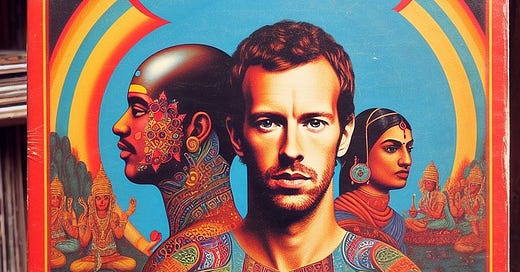So High, So Ham: Self-Discovery Through Coldplay Music and Indian Mantra
Unveiling the Escape Point: How a pop song led me to a deeper truth
So High, So Ham: Self-Discovery Through Coldplay Music and Indian Mantra — AI Image by Author (Bing).
AI Image by Author (Bing).
When I listened to Coldplay’s “Hymn for the Weekend,” one detail literally struck me — the incredible assonance, both in sound and meaning, between the words “So High” in the chorus and the Hindu mantra “So Ham” — “I (the Inner Self) am That” — the Universe — the Ultimate Reality, in Sanskrit. The phonetic proximity of the two expressions “So high” and “So ham” was something astonishing.
Powerful assonance
But what truly surprised me was grasping the profound echo of meanings between that pop verse and the ancient spiritual maxim. It wasn’t just another background song, but an intimate dialogue, with Chris Martin’s crystalline voice seeming to speak directly to me.
For about three and a half years, I have been immersed in the study of Vedanta, the vast Indian philosophy that explores the identity of the individual with the Absolute. On this journey of discovery and internalization of its concepts, the Mahavakya, (Great Statement in Hinduism), “So Ham” has emerged as a precious key to understanding my true nature. This mantra, seemingly simple yet so powerful, is not just a phrase to recite, but a truth to live every day.
Melody
As Coldplay’s melody spread through the air, I perceived a surprising synchronicity between the message of the song and that of the mantra “So Ham.” It was as if the words “So High,” with that unexpected assonance in both sound and meaning with “So Ham,” were a call, an echo of that same fundamental truth that I have been making my own through the study of Vedanta.
Escape point
According to the Indian philosopher Bhartrhari, the meaning of a text is not the sum of its parts, but rather an “escape point” that emerges from their interaction. This concept applies perfectly to “Hymn for the Weekend,” where “So High” becomes that escape point that leads me to a deeper understanding.
Dhvani
In the Indian tradition, the poet is seen only as a medium who conveys the evocative energy of language to the audience. This energy, called Dhvani, goes beyond the literal and figurative meaning, leading to an emotional intuition of the underlying message. It’s a mystery, an enigma even for the poet, because such evocative energy, the vyanjana-vyapara, is generated by language itself.
Rasa and Sahrdaya
The philosopher Abhinavagupta, in his commentary on the Natya Shastra, an important Hindu philosophical work, affirms that the poet’s intention (rasa) is not conveyed to the audience through explicit statements, but through subtle suggestions that the attuned audience, the “sahrdaya,” recognizes in a flash of intuition. In that moment of aesthetic passion, the audience becomes one with the poet, reaching the same level of understanding of the poetic intention. So sahrdaya means having similar thinking and similar feelings as the author of the artwork.
Transcending human emotions
The rasa, the emotional essence of the work, transcends human emotions and is likened to an intermittent light, a glimmer of the Atman that shines every time emotions are idealized in poetry and drama.
As Abhinavagupta states:
“When he listens to sweet songs when he touches sandalwood when he is no longer content to remain in the middle and becomes indifferent when a tense vibration begins in his heart, then it is called the power of bliss.”
Atman
Through these profound words, we can see how music, like poetry, is a medium for the Atman (Inner Immutable Self), transforming both creator and listener into harmonious recipients of the divine message.
Coldplay’s song, with its repeated “So High,” thus becomes a vehicle for a spiritual experience that goes beyond superficial listening, inviting us to a deeper connection with the divine and an understanding of our true essence.
Moreover,, It was incredible to discover only today that the music video for the song was filmed in Mumbai, India.
How did this impact my daily life?
On my journey through music and spirituality, I have discovered that the words of a song can be much more than mere sounds. According to the tradition of Advaita Vedanta, Sabda Bhavana refers to the emotional and intuitive understanding of sacred texts, a process of internalizing the teachings and experiencing their emotional resonance, beyond the literal meaning.
“Hymn for the Weekend” and the mantra “So Ham” might seem like distant worlds, yet for me they have become a single stream of awareness that constantly reminds me of the beauty and depth of life. Music and spirituality are two universal languages that, when they meet, can create moments of pure magic and elevation.
What do you think about my article?
Feel free to leave a comment.
I have woven tales to share, for any who care to read them. My books await you on Google Books. Check also my stories on Medium.com.
I am actively involved in helping to train AI models to become better writers. Therefore, I would be grateful to anyone who is in contact with this industry to recommend me to the right people. Thanks.
I would be honoured if you considered subscribing to the Premium Contents of my Vedanta Substack and leaving feedback, comments, and suggestions both on this page and by writing to me at cosmicdancerpodcast@gmail.com.
Visit my BuyMeACoffee page.
Thanks for reading.




